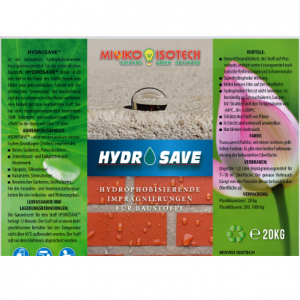| Miviko Isotech |

| No Title | 0.72 MB |
| Registration Date | 13 Feb 2022 |
| Revision Date | 13 Feb 2022 |
| Share |
Construction Masonry Materials
Coating
HYDROSAVE™ is a water based nano super hydrophobic coating. It is designed to impart water repellency to wide variety of materials for prevention, repair and maintenance of the buildings. Unlike difference coatings, HYDROSAVE™ does not seal the pores at the surface of building materials . But it penetrates into the pores and forms a nano layer on the pore walls. These pores no longer be wetted by water and the capillary uptake of water is prevented.
Water can no longer penetrate inside through capillaries, as water is a polar liquid and it cannot reach with non polar, hydrophobic surface. Untreated surface of buildings are wetted immediately by water. In other words, drops of water spreads out and rapidly absorbed by building material. The surface treated with HYDROSAVE™, the drop of water is repelled and stands in the form of bead and does not penetrate inside.
The pores on the surface may vary from 5 to 200 nm. But the size of HYDROSAVE™ is only 4 – 6 nm (0.005 micron) Conventional water repellents give only a short term protection by forming a surface film. Long term protection is possible only by nano sized water repellent, which penetrates up to 12 mm into the surface providing capillary coating. The life expectation on the coatings is more than 12 years.
An unprotected building can absorb over 1 ltr of water per sq.ft in 6 hours. A concrete block can absorb 2 lts of water. This rain water absorption causes multiple damages to the buildings. When the building materials come into contact with water, they absorb an amount of water which depends upon the porosity, resulting in penetration of water through the wall, cracks caused by swelling and shrinkage, destruction of concrete caused by corrosion of reinforced steel, lime leaching, chemical corrosion, binder transformation, etc.,